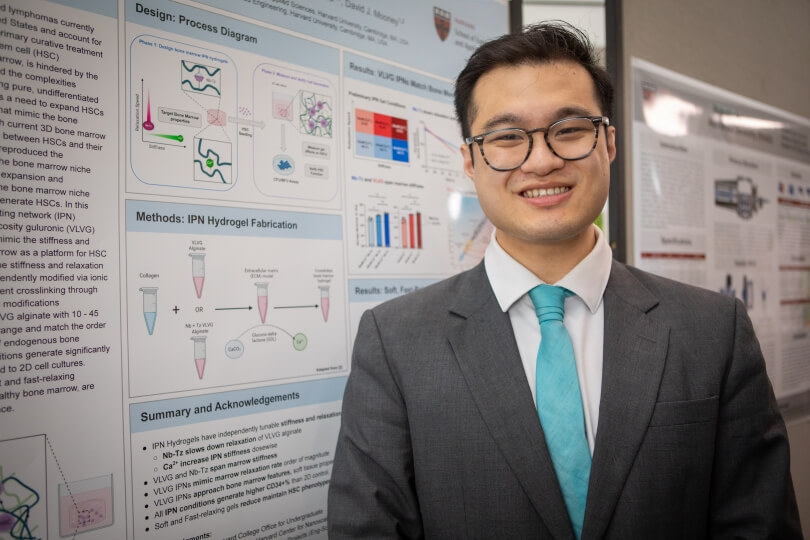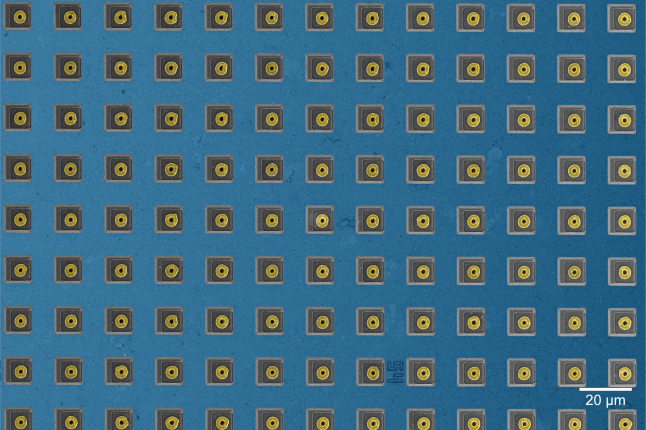News
Andrew Lu, S.B. '24, in bioengineering (Eliza Grinnell/SEAS)
Andrew Lu loves working in labs. He fell in love with it as a high schooler in Cincinnati, where he was a research intern at Cincinnati Children's Hospital Medical Center. He’d sort and micropipette tiny structures called organoids that were used in drug testing, and think about ways to automate and speed up the process.
“I was interested in research and engineering, and I really liked building things,” he said. “It was the first time I saw research have a potential direct impact on patients’ lives. I started in bioengineering because I liked the link between what you do in the lab and aiding someone’s life in the future.”
Lu is about to graduate with an S.B. in bioengineering from the Harvard John A. Paulson School of Engineering and Applied Sciences (SEAS). While he’s been a member of several student organizations on campus, the bulk of his free time has been spent in faculty research labs. He started with the summer Program for Research in Science and Engineering in the Jennifer Lewis Lab after his freshman year, then he spent the next two years in the Samir Mitragotri Lab for Drug Delivery. For his senior year, he switched to the David Mooney Laboratory for Cell and Tissue Engineering, where he developed his senior capstone project. Whether it was kidney organoid research in the Lewis Lab, cellular backpacks in the Mitragotri Lab, or his capstone project, all of Lu’s research has been about using bioengineering to devise novel and accessible solutions to diseases and health challenges.
“Harvard has so many opportunities to get into research, and I think it’s important for everyone with even a little interest to give it a try,” Lu said. “It’s not easy work, it’s a lot of late hours, but it offers a lot of freedom. It’s probably the only work environment I really know. The only other paid job experience I’ve had was at a Wendy’s in my freshman year of high school. After that, I was always in the lab.”
Lu’s capstone project focused on hematopoietic stem cells, which are the stem cells that can become all blood and immune cells. These stem cells have shown great potential in combating blood diseases such as leukemia by replacing diseased cells, but extracting and preserving them outside the body has proven difficult.
“They’re rare, and have to be extracted from pretty limited sources, the most prevalent and well-known being bone marrow,” he said. “And when you take these cells outside of their natural homes, like the bone marrow, they get kind of homesick. They may divide into other cell types when we’d want them to stay stem cells.”
Previous research in Mooney’s lab has already shown that changing the physical environment can regulate the specific function and phenotype of immune cells. Lu extended these observations in the opposite direction by designing a hydrogel that better mimics the physical structure of bone marrow. The goal is to create an environment in which the hematopoietic stem cells think they’re still in the bone marrow. By harnessing the properties of the bone marrow in a platform outside the body, Lu created an environment that encourages hematopoietic stem cells to maintain their stem cell phenotype and regenerate to produce more stem cells.
“I was interested in hematopoietic stem cells because I did a project on this topic in Mooney’s class on tissue engineering,” Lu said. “Not only is it hard to maintain these cells outside of the body, but there just aren’t many donors whose cells are compatible with certain patients. The availability of donors is highly associated with one’s socioeconomic status, so if there’s a lack of diversity in the donor pool to meet the needs of the patients, there aren’t enough cells to go around. A project like this could expand these rare cell samples, and make them more available to patients.”
As busy as he’s been in the labs, this is exactly why he came to Harvard in the first place. He came for the research opportunities, and the chance to not only take courses with fellow bioengineering students but to also interact with students across a range of engineering disciplines.
“I’ve met some of the coolest people here,” he said. “Not only the smartest and most accomplished people I’ve ever seen before, but also some of the nicest and friendliest people. I really appreciate the ability to take classes with such a diverse group of people who I can connect with.”
Once he graduates, Lu plans to continue researching as a research assistant as he applies for MD-Ph.D. programs.
Said Lu, “I’m still interested in blood disorders, and want to approach treating them from a clinical perspective which I haven’t seen yet.”
Topics: Bioengineering, Health / Medicine, Undergraduate Student Profile
Cutting-edge science delivered direct to your inbox.
Join the Harvard SEAS mailing list.
Press Contact
Matt Goisman | mgoisman@g.harvard.edu



